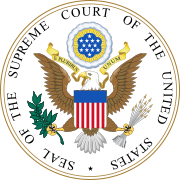|
List of United States Supreme Court cases, volume 247
This is a list of cases reported in volume 247 of United States Reports, decided by the Supreme Court of the United States in 1918. Justices of the Supreme Court at the time of volume 247 U.S.The Supreme Court is established by Article III, Section 1 of the Constitution of the United States, which says: "The judicial Power of the United States, shall be vested in one supreme Court . . .". The size of the Court is not specified; the Constitution leaves it to Congress to set the number of justices. Under the Judiciary Act of 1789 Congress originally fixed the number of justices at six (one chief justice and five associate justices).[1] Since 1789 Congress has varied the size of the Court from six to seven, nine, ten, and back to nine justices (always including one chief justice). When the cases in volume 247 were decided the Court comprised the following nine members:
Notable Case in 247 U.S.Hammer v. DagenhartIn Hammer v. Dagenhart, 247 U.S. 251 (1918), the Supreme Court struck down a federal law regulating child labor. During the Progressive Era, public sentiment in the United States turned against what was perceived as increasingly intolerable child labor conditions. In response, Congress passed the Keating–Owen Act, prohibiting the sale in interstate commerce of any merchandise that had been made either by children under the age of fourteen, or by children under sixteen who worked more than sixty hours per week. By a 5-4 majority, the Supreme Court struck down the Keating–Owen Act, holding that the Commerce Clause did not give Congress the power to regulate working conditions. In a dissenting opinion, Justice Oliver Wendell Holmes Jr., joined by three other justices, argued that goods manufactured in one state and sold in other states were, by definition, interstate commerce, and so Congress should have power to regulate the manufacturing of those goods. In 1941 Hammer v. Dagenhart was overruled by the Court in United States v. Darby Lumber Co. Citation styleUnder the Judiciary Act of 1789 the federal court structure at the time comprised District Courts, which had general trial jurisdiction; Circuit Courts, which had mixed trial and appellate (from the US District Courts) jurisdiction; and the United States Supreme Court, which had appellate jurisdiction over the federal District and Circuit courts—and for certain issues over state courts. The Supreme Court also had limited original jurisdiction (i.e., in which cases could be filed directly with the Supreme Court without first having been heard by a lower federal or state court). There were one or more federal District Courts and/or Circuit Courts in each state, territory, or other geographical region. The Judiciary Act of 1891 created the United States Courts of Appeals and reassigned the jurisdiction of most routine appeals from the district and circuit courts to these appellate courts. The Act created nine new courts that were originally known as the "United States Circuit Courts of Appeals." The new courts had jurisdiction over most appeals of lower court decisions. The Supreme Court could review either legal issues that a court of appeals certified or decisions of court of appeals by writ of certiorari. On January 1, 1912, the effective date of the Judicial Code of 1911, the old Circuit Courts were abolished, with their remaining trial court jurisdiction transferred to the U.S. District Courts. Bluebook citation style is used for case names, citations, and jurisdictions.
List of cases in volume 247 U.S.Notes and references
External links
|
|||||||||||||||||||||||||||||||||||||||||||||||||||||||||||||||||||||||||||||||||||||||||||||||||||||||||||













